Veeam Backup & Replication is a backup solution developed for VMware vSphere and Microsoft Hyper-V virtual environments. Veeam Backup & Replication provides a set of features for performing data protection and disaster recovery tasks. This blog describes the installation and configuration of Veeam Backup & Replication 9.5 Update4.
Veeam Backup & Replication Installation
Before you install Veeam Backup & Replication, check the following prerequisites:
- A machine on which you plan to install Veeam Backup & Replication must meet the system requirements. For more information, see System Requirements.
- A user account that you plan to use for installation must have enough permissions. For more information, see Required Permissions.
- Backup infrastructure components communicate with each other over specific ports. These ports must be open. For more information, see Used Ports.
- Veeam Backup & Replication requires .NET Framework 4.6. If .NET Framework 4.6 is not installed, the Veeam Backup & Replication setup will install it on the backup server.
- Veeam Backup & Replication requires Microsoft SQL Server deployed either locally on the backup server or remotely. If Microsoft SQL Server is not installed, the Veeam Backup & Replication setup will install it locally on the backup server:
- For machines running Microsoft Windows 7, Microsoft Windows Server 2008 or Microsoft Windows Server 2008 R2, the setup will install Microsoft SQL Server 2012 SP4 Express Edition.
- For machines running Microsoft Windows Server 2012 or later, the setup will install Microsoft SQL Server 2016 SP1 Express Edition.
- If Microsoft SQL Server was installed by the previous product version, Veeam Backup & Replication will connect to the existing configuration database, upgrade it (if necessary) and use it for work.
- You must remove Veeam Backup & Replication components of versions that are not supported by the upgrade procedure from the target machine. You may also need to remove earlier versions of other Veeam products and components.
Download the latest version of the Veeam Backup & Replication installation image from the Download Veeam products page. After you mount the image run the Setup.exe file from the image or disk.
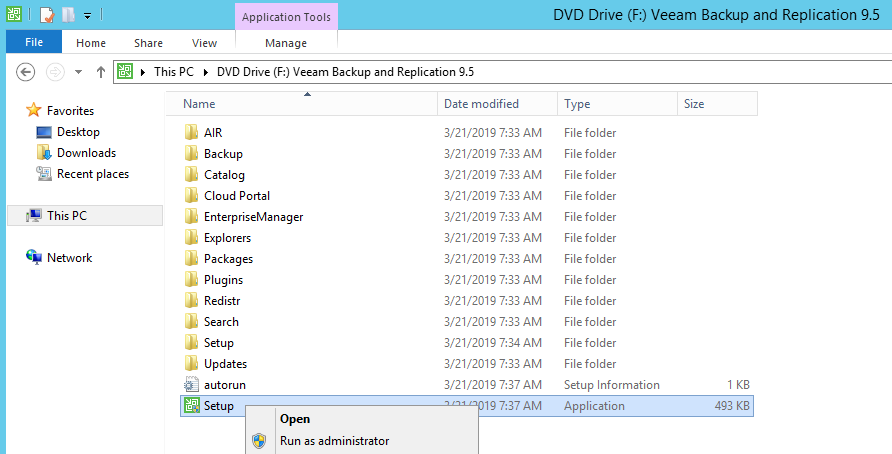
In the Veeam Backup & Replication section of the splash screen, click Install.
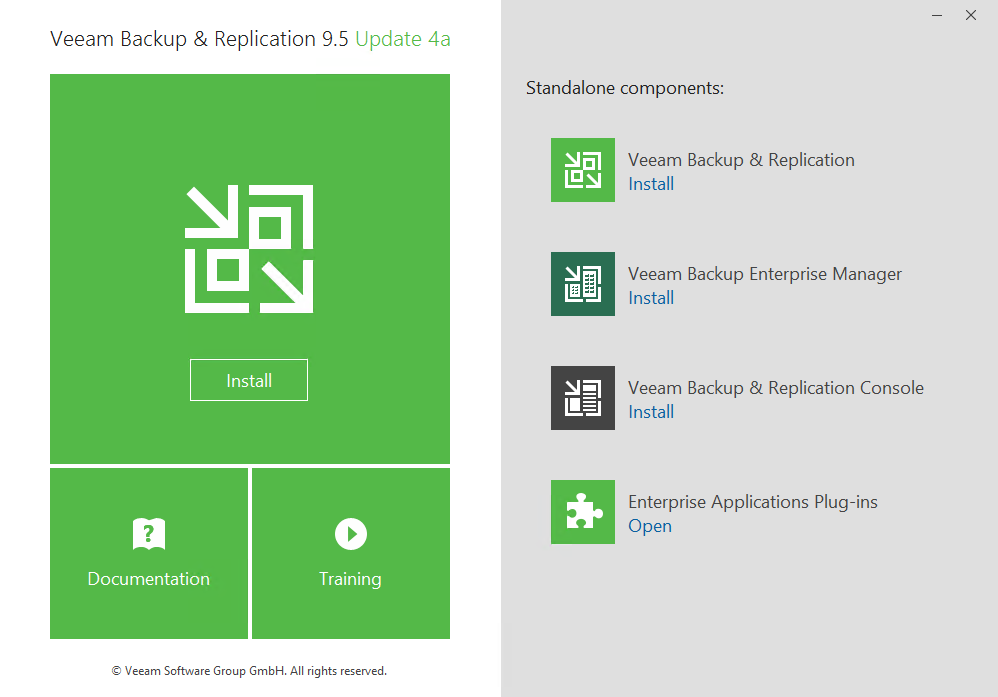
At the License Agreement step of the wizard, you must accept the license agreement for Veeam and 3rd party components that Veeam incorporates. If you do not accept the license agreement, you will not be able to pass to next step of the setup wizard.
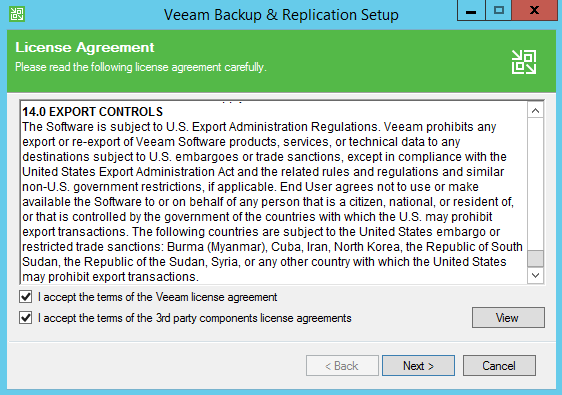
At the Provide License step of the wizard, you must specify what license for Veeam Backup & Replication you want to install. You can install the following types of licenses:
- Evaluation license that was sent to you after you downloaded the product.
- Purchased full license.
- No license.
In this case, after installation Veeam Backup & Replication will operate in the Community Edition mode. You can switch to the full version of the product if you install the license.
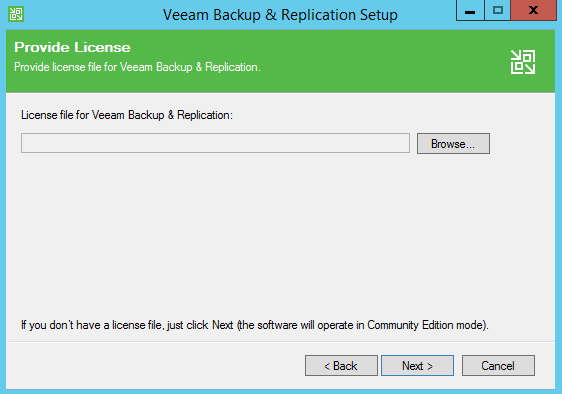
At the Program Features step of the wizard, you can check what components the setup wizard will install on the machine and choose the installation folder.
The setup wizard installs the following components:
- Veeam Backup & Replication
- Veeam Backup Catalog (component responsible for storing VM guest OS indexing data)
- Veeam Backup & Replication Console
The setup wizard also installs the following components in the background:
- Veeam Explorer for Microsoft Active Directory
- Veeam Explorer for Microsoft Exchange
- Veeam Explorer for Oracle
- Veeam Explorer for Microsoft SQL Server
- Veeam Explorer for Microsoft SharePoint
- Veeam Explorer for Microsoft OneDrive for Business
- Veeam Backup PowerShell Snap-In these components do not require additional licenses. They are integrated with Veeam Backup & Replication.
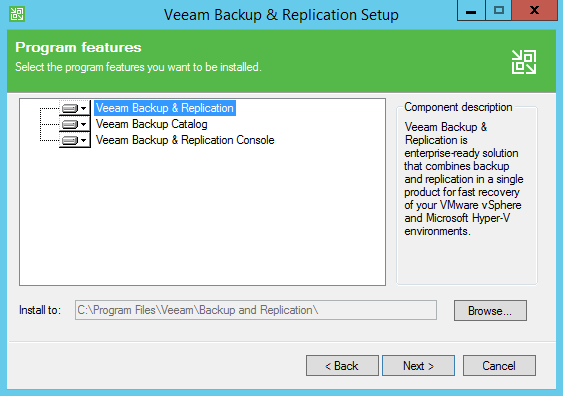
At the System Configuration Check step of the wizard, the setup wizard checks if all prerequisite software is installed on the machine. If required software components are missing, the setup wizard will offer you to install them. You can install missing components automatically or manually.

Install and Re-run to full the required features

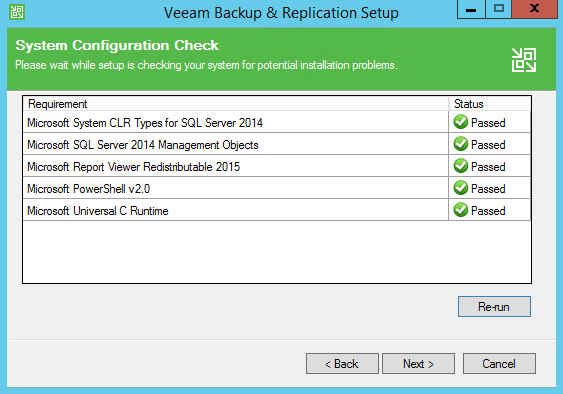
At the Default Configuration step of the wizard, you can select to install Veeam Backup & Replication with default installation settings or specify custom installation settings. To use custom installation settings, select the Let me specify different settings check box. The setup wizard will include additional steps that will let you configure installation settings.
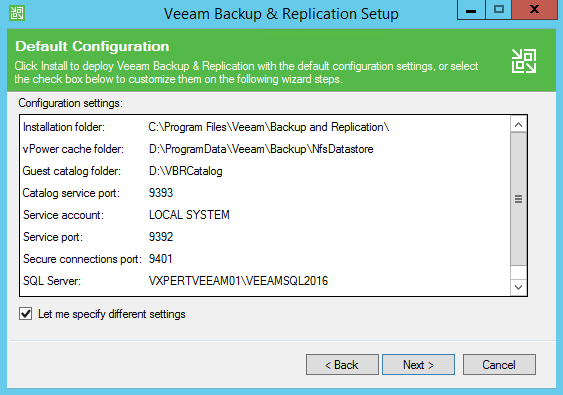
The Service Account step of the wizard is available if you have selected to configure installation settings manually. You can select an account under which you want to run the Veeam Backup Service:
- LOCAL SYSTEM account (recommended, used by default)
- Another user accounts
The user name of the account must be specified in the DOMAIN\USERNAME format.
The user account must have the following rights and permissions:
- The account must be a member of the Administrators group on the machine where Veeam Backup & Replication is installed.
- The account must have db_owner rights for the configuration database.
Veeam Backup & Replication automatically grants the Log on as service right to the specified user account.

The SQL Server Instance step of the wizard is available if you have selected to configure installation settings manually.
You can select a Microsoft SQL Server on which you want to deploy the configuration database and choose the authentication mode.
- Select a Microsoft SQL Server:
- If a Microsoft SQL Server is not installed locally or remotely, select the Install new instance of SQL Server option. The setup will install Microsoft SQL Server locally on the backup server:
- For machines running Microsoft Windows 7, Microsoft Windows Server 2008 or Microsoft Windows Server 2008 R2, the setup will install Microsoft SQL Server 2012 SP4 Express Edition.
- For machines running Microsoft Windows Server 2012 or later, the setup will install Microsoft SQL Server 2016 SP1 Express Edition.
- If a Microsoft SQL Server is already installed locally or remotely, select the Use existing instance of SQL Server option. Enter the instance name in the HOSTNAME\INSTANCE format. In the Database field, specify a name for the Veeam Backup & Replication configuration database.
- Select an authentication mode to connect to the Microsoft SQL Server instance: Microsoft Windows authentication or SQL Server authentication. If you select the SQL Server authentication, enter credentials for the Microsoft SQL Server account.
If the configuration database already exists on the Microsoft SQL Server (for example, it was created by a previous installation of Veeam Backup & Replication), the setup wizard will notify about it. To connect to the detected database, click Yes. If necessary, Veeam Backup & Replication will automatically upgrade the database to the latest version.
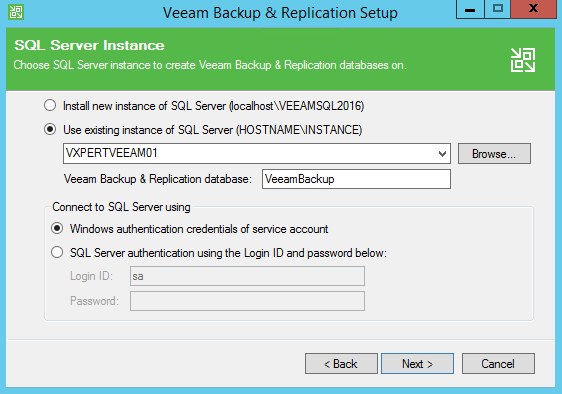
The Port Configuration step of the wizard is available if you have selected to configure installation settings manually.
You can customize port number values that will be used for communication between backup infrastructure components:
- Catalog service port. The catalog service port is used by the Veeam Guest Catalog Service to replicate catalog data from backup servers to Veeam Backup Enterprise Manager. By default, port 9393 is used.
- Veeam Backup Service port. The service port is used by Veeam Backup Enterprise Manager to collect data from backup servers. In addition to it, the Veeam Backup & Replication console uses this service port to connect to the backup server. By default, port 9392 is used.
- Secure connections port. The secure connections port is used by the mount server to communicate with the backup server. By default, port 9401 is used.
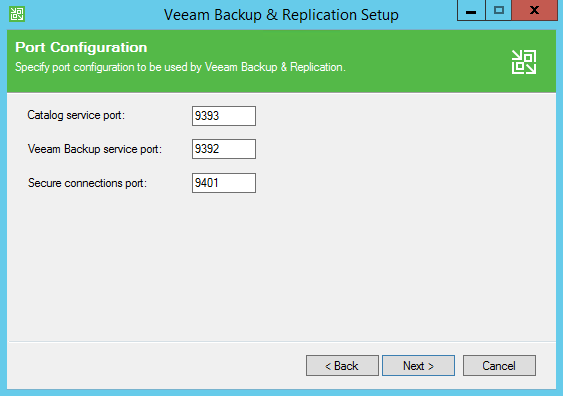
The Data Locations step of the wizard is available if you have selected to configure installation settings manually.
You can specify where indexing data must be stored.
- The vPower NFS section is applicable only to VMware vSphere environments. You do not need to configure this data location for Microsoft Hyper-V environments.
- In the Guest file system catalog section, specify a path to the folder where index files must be stored.
By default, the setup wizard creates the VBRCatalog folder on a volume with the maximum amount of free space, for example: C:\VBRCatalog.
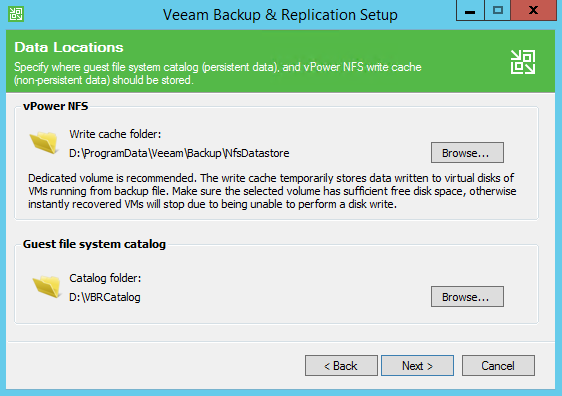
The Ready to Install step of the wizard is available if you have selected to configure installation settings manually.
You can review installation settings and start the installation process.
- If you want Veeam Backup & Replication to periodically check and notify you about product updates, select the Check for updates once the product is installed and periodically check box.
- Click Install to begin the installation.
- Wait for the installation process to complete and click Finish to exit the setup wizard.
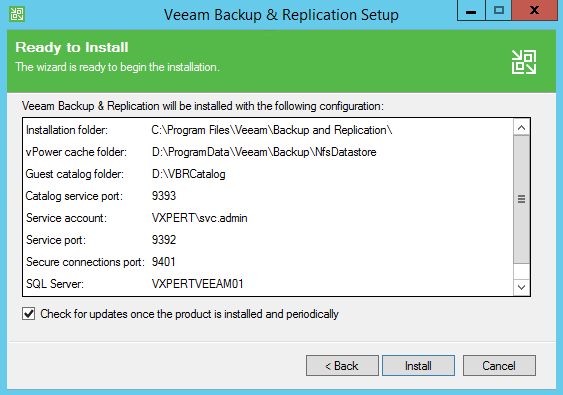

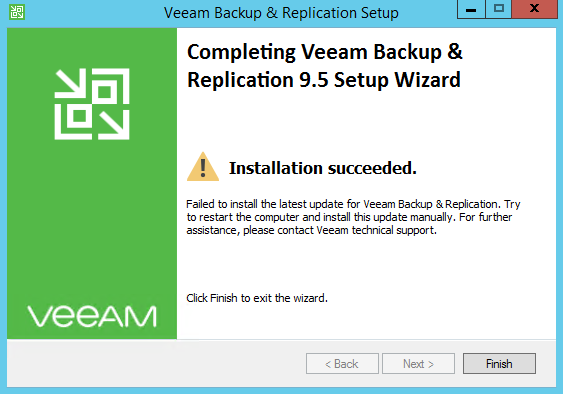
Reboot the server on open the Veeam Backup & Replication icon on desktop
Veeam Backup & Replication Configuration
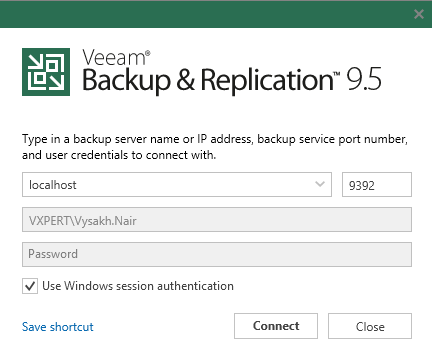
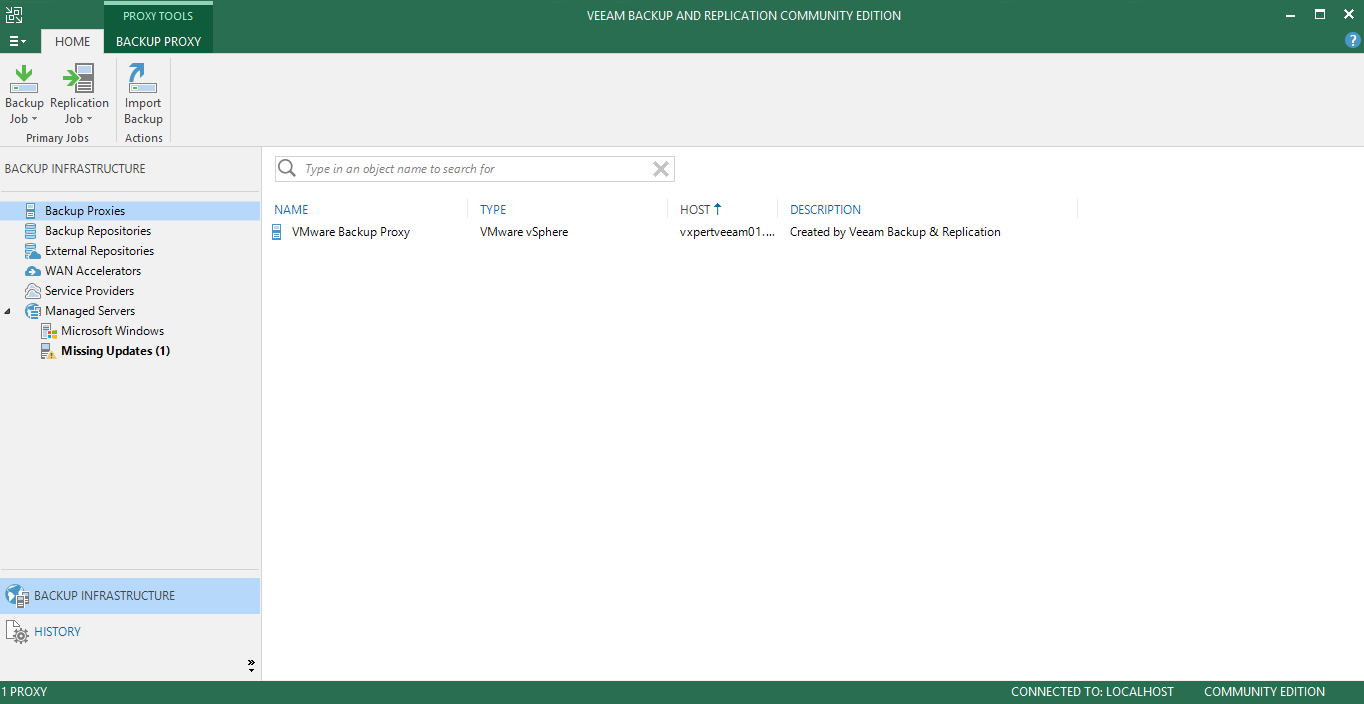
Below are the main components in Veeam Backup and Replication
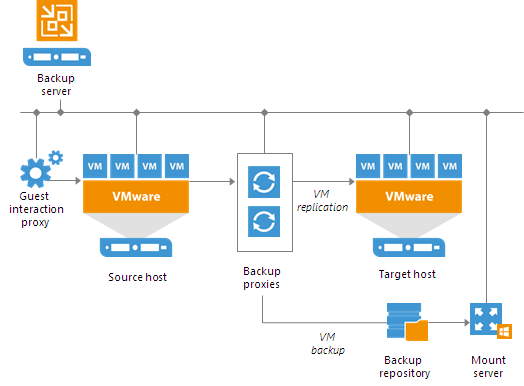
Backup Proxies
Veeam proxy is one of the main components of Veeam Backup and replication. In small environments when installation is “All-In-one” machine, the Veeam Proxy gets installed on the same box as the rest of the components. In larger environments, the backup proxy role is assigned to one or multiple Windows servers to share the load. Veeam proxy sits between the data source and target and is used to process jobs and deliver backup traffic. It allows to offload the Veeam Backup Server and have better performance resulting shorter backup window. Backup proxy takes care of the data traffic between VMware vSphere and Veeam Backup and replication during backup, replication, copy or migration jobs. The Veeam proxy is used also during restores. A backup proxy can be installed on a physical server or within a virtual machine. Backup proxy is running a data mover service which needs to be deployed remotely when adding an additional Windows based server to a management console. This process is simple and can be done remotely.
Backup Repositories
A backup repository is a storage location where Veeam keeps backup files, VM copies and metadata for replicated VMs. To configure a backup repository, you can use the following storage types:
- Direct attached storage. You can add virtual and physical servers as backup repositories:
- Network attached storage. You can add CIFS (SMB) shares as backup repositories.
- Deduplicating storage appliances. You can add the following deduplicating storage appliances as backup repositories:
- Object storage. You can use cloud storage services as backup repositories. For details, see Object Storage.
External Repositories
Veeam Backup & Replication allows you to add Amazon S3 object storage repositories that contain backups created by Cloud Protection Manager. Cloud Protection Manager is a Veeam solution that creates backups of Elastic Block Stores (EBS) disk volumes of Amazon EC2 instances. Such backups are placed directly to Amazon S3 object storage repositories which you can add to the Veeam Backup & Replication console as External Repositories. To upload backed up data to Amazon S3 object storage, Cloud Protection Manager uses Veeam VM Backup API to preserve the backup structure in the native Veeam format.
Below operations can be performed by addition of an Amazon S3 object storage as external repositories to the Veeam Backup & Replication console.
- Restore EC2 instances to AWS
- Restore machines to Microsoft Azure
- Restore guest OS files
- Copy EC2 backups to on-premises repositories
- Govern retention policies
- Remove EC2 backups from external repositories
WAN Accelerators
Offsite backup and replication always involve moving large volumes of data between remote sites. The most common problems that backup administrators encounter during offsite backup and replication are:
- Insufficient network bandwidth to support VM data traffic
- Transmission of redundant data
To solve these problems, Veeam Backup & Replication offers the WAN acceleration technology that helps optimize data transfer over WAN. Veeam WAN acceleration is a built-in feature and does not add complexity and cost to the backup infrastructure.
The WAN acceleration technology is specific for remote jobs: backup copy jobs and replication jobs.
Managed Servers
Managed server windows in Veeam Backup and Replication allows to add servers like VMware vSphere, Microsoft Hyper-V, Microsoft Windows and Linux.
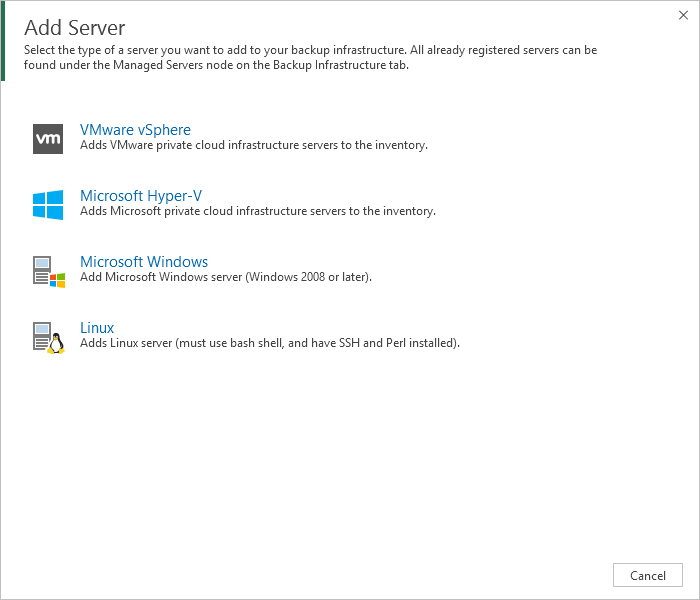
Thanks,
If you have any comments, please drop me a line.
I hope this article was informative, and don’t forget to buy me a coffee if you found this worth reading.



Leave a Reply